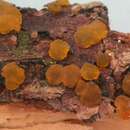fr
noms dans le fil d’Ariane


Die Gallerttränen oder Tränenpilze (Dacrymyces, syn. Arrhytidia, Dacryomyces und Septocolla) sind eine Gattung aus der Familie der Gallerttränenverwandten (Dacrymycetaceae) und umfassen Arten mit gelatinösen und überwiegend blass gelb bis leuchtend orange gefärbten Fruchtkörpern. Sie besiedeln Totholz und erzeugen im Substrat eine Weißfäule.
Die Typusart der Gattung ist die Zerfließende Gallertträne (Dacrymyces stillatus).[1]
Die pustel-, scheiben- oder kreiselförmigen, selten etwas gestielten Fruchtkörper besitzen eine weiche bis fest gelatinöse Konsistenz (Name!). Sie sind durch Carotinoide mehr oder weniger orange gefärbt. Gallerttränen fruktifizieren einzeln oder fließen in größere, unförmige Gebilde zusammen. Die Oberfläche ist entweder glatt oder wellig.[2][3]
Die Fruchtkörper bestehen aus farblosen, schnallenlosen oder -tragenden Hyphen. Das Hyphensystem ist monomitisch. Hyphidien sind entweder vorhanden oder fehlen. Die farblosen und schmal keulenförmigen Basidien besitzen jeweils zwei große Sterigmen (Epibasidien). Die Sporen sind farblos, oft durch Querwände geteilt und keimen mit Konidien oder Keimschläuchen aus. Einige Arten besitzen ein imperfektes Stadium.[2][3]
Gallerttränen sind Saprobionten auf meist entrindetem Holz in der frühen Initial- bis zur frühen Finalphase der Zersetzung. Bei genügend Feuchtigkeit besiedeln sie auch verbautes Holz[4]. Im Substrat verursachen sie eine Weißfäule.[3]
Weltweit umfasst die Gattung über 30 Arten.[3] In Europa kommen 16 Arten vor bzw. sind dort zu erwarten.[5]
Bewurzelte Gallertträne (Dacrymyces capitatus)
Riesen-Gallertträne (Dacrymyces chrysospermus)
Kleinste Gallertträne (Dacrymyces minor)
Querseptierte Spore der Zerfließenden Gallertträne (Dacrymyces stillatus)
Die Gallerttränen oder Tränenpilze (Dacrymyces, syn. Arrhytidia, Dacryomyces und Septocolla) sind eine Gattung aus der Familie der Gallerttränenverwandten (Dacrymycetaceae) und umfassen Arten mit gelatinösen und überwiegend blass gelb bis leuchtend orange gefärbten Fruchtkörpern. Sie besiedeln Totholz und erzeugen im Substrat eine Weißfäule.
Die Typusart der Gattung ist die Zerfließende Gallertträne (Dacrymyces stillatus).
Dacrymyces is a genus of fungi in the family Dacrymycetaceae. Species are saprotrophs and occur on dead wood. Their distribution is worldwide. Basidiocarps (fruit bodies) are ceraceous to gelatinous, often yellow to orange, and typically disc-shaped to cushion-shaped.
The genus has traditionally been differentiated from other genera in the Dacrymycetaceae on the basis of basidiocarp morphology, following (in recent years) the monograph of New Zealand mycologist Robert McNabb.[3] Molecular research, based on cladistic analysis of DNA sequences, has however shown that morphology is not a good indicator of natural relationships within the Dacrymycetaceae.[4] As a result several species formerly referred to Dacrymyces have been moved to Dacryonaema[4] or Dendrodacrys.[5][6]
{{cite journal}}: CS1 maint: multiple names: authors list (link) {{cite journal}}: CS1 maint: multiple names: authors list (link) Dacrymyces is a genus of fungi in the family Dacrymycetaceae. Species are saprotrophs and occur on dead wood. Their distribution is worldwide. Basidiocarps (fruit bodies) are ceraceous to gelatinous, often yellow to orange, and typically disc-shaped to cushion-shaped.
The genus has traditionally been differentiated from other genera in the Dacrymycetaceae on the basis of basidiocarp morphology, following (in recent years) the monograph of New Zealand mycologist Robert McNabb. Molecular research, based on cladistic analysis of DNA sequences, has however shown that morphology is not a good indicator of natural relationships within the Dacrymycetaceae. As a result several species formerly referred to Dacrymyces have been moved to Dacryonaema or Dendrodacrys.
Dacrymyces es un género de hongos del orden Dacrymycetales. En 2016 Catalogue of Life reseñaba un total de 59 especies para el género, ampliamente distribuidas.[3]
Dacrymyces es un género de hongos del orden Dacrymycetales. En 2016 Catalogue of Life reseñaba un total de 59 especies para el género, ampliamente distribuidas.
Dacrymyces Nees (łzawnik) – rodzaj grzybów należący do rodziny łzawnikowatych (Dacrymycetaceae)[1].
Pozycja w klasyfikacji według Index Fungorum: Dacrymycetaceae, Dacrymycetales, Incertae sedis, Dacrymycetes, Agaricomycotina, Basidiomycota, Fungi[1].
Synonimy: Arrhytidia Berk. & M.A. Curtis, Hydromycus Raf., Septocolla Bonord[2].
Nazwę polską podał Józef Jundziłł w 1830 r[3].
Grzyby nadrzewne, saprotrofy i pasożyty. Wytwarzają poduszeczkowate owocniki o galaretowatej lub śluzowatej konsystencji. Kształt owocników miseczkowaty, stożkowaty, czasami zróżnicowany na trzon i główkę[4].
Wykaz gatunków (nazwy naukowe) na podstawie Index Fungorum. Obejmuje on wszystkie gatunki występujące w Polsce i niektóre inne. Uwzględniono tylko gatunki zweryfikowane o potwierdzonym statusie[5]. Nazwy polskie według checklist Władysława Wojewody[3].
Dacrymyces Nees (łzawnik) – rodzaj grzybów należący do rodziny łzawnikowatych (Dacrymycetaceae).